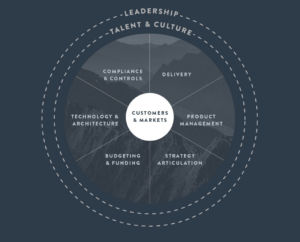6 Key Things That Block True Business Agility—And How to Address Them
Once we get started on the journey toward becoming Agile—whether we’re at the start or further along in the process—we often notice there’s conflict between different parts of the organization. This is usually because we start with team-level Agility thinking that’s all we need. But what we may have failed to consider is how the rest of the organization will need to change to exploit this new delivery capability.
What happens is we form product aligned teams, and we get them working well enough, but they are in conflict with other parts of the organization that are there to protect other interests and concerns we can’t overlook. The things we can’t overlook then get in our way.
The fact is, teams don’t own all the responsibilities and capabilities within the organization, for example, around things like finance, tech, and compliance. Yet these areas are valid organizational concerns, so we need to allow them to constrain the way the teams function.
We can’t just sweep these things aside and say, “Just trust the teams.” So how do we go about having these conversations, thinking about them meaningfully, and articulating them fully?
We need to begin to understand the concerns that are blocking us. And we need to be able to understand what we have to do to best support our organization’s goals that are aligned with our customers and markets.
Overcoming Our Conflicts
There are 6 areas of concern we’ve determined from the last decade working with our clients. When these areas are effectively addressed, and aligned with customers and markets, we can rebuild them in a system that opens the way to Business Agility. Ultimately, our goal isn’t just to be Agile. It’s to exploit Agile and how it can enable us to reach our business goals—not just at the team level, but across the entire organization.
While some of these 6 concerns must be addressed in an order to clear the path for something that logically comes next, many are non-linear and we may go back and forth addressing necessary parts of them as we move forward on our journey.
Here are the 6 key things standing in the way of real Business Agility, and how we can remediate and manage each one:

Delivery
When we try to put teams in place, the biggest concern organizations have is whether or not we’re getting the optimal amount of work through the organization—are we working hard enough?
But the optimal investment we can make to get the result we want is to create well-formed teams that are relatively persistent while still immutable enough to respond to change, and designed for resiliency to match the shifting concerns of the organization. These teams can then stay aligned with our interests and what we’re trying to accomplish—products, capabilities, or value streams. Then we need to find out what the maximum capacity is that each team can produce and consume, and maximize the throughput that way.
We must make a shift to design the organization from the inside out rather than the outside in. Instead of trying to keep the teams busy and everyone utilized, we need to understand what the most important things are that we’re gonna solve in the market. It becomes less about, “How busy are people?” and more about, “How much work are we moving through? How much waste are we reducing?”
With stable teams, we can exploit them with our outside-in thinking so the teams produce the right output. When we get our delivery teams aligned to our customers and markets, we can produce more value.
Product Management
We want to be sure we’re making products that are solving the right customer problems. The problem is, most product management organizations in large companies are either operating through command by directive, or just taking orders. In either case, these mentalities mean trying to accommodate whatever the customer wants without forming an opinion and never really connecting the product to something meaningful that’s related to a problem we’re solving.
So what we need to do is communicate value differently. We want to deeply understand our customer and the markets we’re going after. We want to validate and justify our value propositions.
To do this, we have to make a shift from command by directive or “order taking,” to command by intent. We have to aim toward what has the most value—to connect our product management to the market and then connect those value propositions back to our delivery teams.
Strategy Articulation
Strategy articulation in many organizations is often made up of platitudes and slogans. Slogans like, “To be the #1…” although well-intentioned are not really going to tell us how we get from A to B.
Strategy isn’t about “Who do I want to become?” It’s more than just an aspiration. It’s, “How do I apply my limited resources and capacity to achieve an outcome?” Strategy constrains a set of decisions against a limited capacity.
We struggle to connect strategy and execution in an actionable way, which bars us from Agility. So how do we begin to articulate strategy in a real way?
To ensure we’re aligned with our strategy, we first need to know if we have a clear understanding of our priorities around which problems, customers, and markets we need to compete within. We use OKRs that we can tie to value propositions and capability models.
We need to move from having a lack of strategy alignment to having strategic articulation structures—to be able to articulate our strategies in an actionable way, and link that strategy to what we can actually accomplish.
Budgeting & Funding
The project-based funding most organizations start out with can lead to architecture issues, stressed out people, and a general lack of trust and confidence. To remedy this, we have to go back and start with creating a trustworthy system that shows us we’re profitable and meeting the expectations of regulators and shareholders.
This is where moving from Projects to Products comes in and the organizational funding is focused around the products we are building versus viewing our budgeting as something that feeds individual projects.
Technology & Architecture
To be able to respond to customers and markets, we have to be able to deploy software into the market rapidly. We also have to ensure things are done safely and reliably. DevOps, security, and reliability are critically important concerns we can’t ignore.
So what we have to ask is—is the offering we provide customers secure, scalable, and reliable? To get to this point, we have to shift away from Product and Technology encapsulation and toward leveraging more modern practices. If our infrastructure and operations can’t get us there, we’re not going to be able to deploy reliably and securely into the environment.
Compliance & Controls
It’s common for many organizations to have compliance and regulatory requirements that can command and constrain product development efforts and slow down the delivery of customer value. These efforts are partly designed to protect us from real risks and real concerns in our more broken and out of control system of the past. But, over time, this new model is easier to audit and becomes more reliable and responsible.
We have to figure out how to take these real and valid concerns of auditors, regulators and compliance people and integrate them into our governance models and workflow rather than treating them like they are something to be kept off to the side.
Leadership, Talent & Culture
Addressing how we approach leadership, talent, and culture is an enabler for the rest of the 6 areas of concern.
It’s easy to create some teams that can deliver in an Agile way. But when we’re Transforming an entire organization, we have to rethink how we’re standing up talent and culture as well.
We need to ask, do we have the correct culture to help our employees be the best they can be? Are we staffing in a way that sets our people up for safety and success in the new model?
We also must be thoughtful about how we lead and manage the teams so we can create the necessary safety for building out the rest of the emerging model. Leaders need to build trusted systems they can delegate into rather than working within the system of delivery alone. It’s about a shift in focus to the system being trustworthy so that customers can trust us to deliver on time and as promised.
Our training programs should also introduce the new model and how it operates, including terminology, etc. Off the shelf training in Scrum or any other Agile practices isn’t going to teach you how to think and operate in this type of situation where the model is emerging.
More Than Technology
Achieving business Agility isn’t simply a technology effort. All of the organizational concerns must be considered and adapted, thus creating the organizational conditions to achieve the necessary capabilities while also responsibly maintaining the ongoing organizational concerns—and ensuring they’re all aligned with our customers and markets.
It’s important that we also note this is not necessarily a linear process, but rather one where we address what needs to be addressed, and then look at what can open up the next door toward Agility across the entire org.


